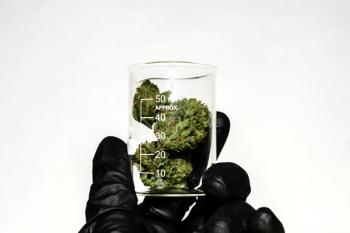
Cannabis Science and Technology
- March/April 2025
- Volume 8
- Issue 2
- Pages: 20-23
Easy GC Injection Set-Up and How to Avoid Peak Splitting of Cannabis Pesticide Samples

This article will briefly introduce GC splitless inlet anatomy and show a simple example for how optimizing injection type and volume, initial GC oven temperature, and extract dilution can improve GC peak shape.
Gas chromatography-mass spectrometry (GC-MS) pesticide testing of cannabis will increase as the number of required pesticides increases. GC analysis of pesticides in cannabis matrices is challenging due to low quantification levels required in dirty sample extracts, which places high demands on the GC inlet. The typical splitless inlet limits sample injection volume and fouls quickly from nonvolatile components in extracts. Popular cannabis sample preparation methods use polar acetonitrile solvent, which is difficult to gas chromatograph on standard non-polar GC columns. This article will briefly introduce GC splitless inlet anatomy and show a simple example for how optimizing injection type and volume, initial GC oven temperature, and extract dilution can improve GC peak shape.
Introduction
Gas chromatography-tandem mass spectrometry (GC-MS/MS) is a powerful analytical technique used for the separation and trace-level analysis of pesticides. Optimizing GC inlet parameters is crucial to ensure accurate and repeatable results, especially since most problems in GC for cannabis samples happen at the start of the analysis. One particular issue that occurs when injecting an acetonitrile extract of cannabis is chromatographic peak splitting, which reduces pesticide detectability, and leads to quantitative inaccuracy due to improper peak integration. This article will show how simple adjustments for two parameters, GC initial oven temperature and sample dilution with toluene, can mitigate peak splitting. Additionally, pulsed splitless injection is demonstrated as a way to improve pesticide detectability by injecting a higher volume of sample.
Injection of a Pesticide Sample into a GC
A liquid solvent sample containing pesticides is syringe injected into a hot GC inlet containing a glass liner, which is often packed with deactivated glass wool.The solvent is vaporized in the GC inlet and a carrier gas sweeps the sample into a cooler GC column where the solvent and pesticides, ideally, condense along a narrow length of the column as a smooth film, Figure 1. In short, the goal is to introduce the sample to the column by going from liquid to vapor and back to liquid. Subsequently, the GC oven is heated to elute the solvent and separate the pesticides for detection.
Solvent and Analyte Focusing on a GC Column for Good Peak Shape
Two key techniques for focusing the analytes (e.g., pesticides) from a sample injection onto a GC column are solvent focusing and analyte focusing. In solvent focusing, the GC oven temperature start is below the boiling point of the solvent (typically, about 20°C below) to condense it on the stationary phase, which helps to focus more volatile components for better peak shapes. Analyte focusing, which can only be used if less volatile pesticides are being analyzed, is accomplished at a temperature above the boiling point of the sample solvent, such that the solvent never condenses. Analytes are “cold trapped” on the GC stationary phase, focusing them for good peak shapes.
Sample Solvent and GC Stationary Phase Polarity Mismatch
A common issue in cannabis pesticide residue analysis by GC is the polarity mismatch between the polar acetonitrile solvent used for extraction and the non-polar GC stationary phase, which is most commonly a 5-phase column. This mismatch can lead to split peaks and inaccurate results.To visualize this issue, imagine water beading on a recently waxed car surface, then consider acetonitrile acting the same on a GC column. These discrete populations of acetonitrile in the GC column, each containing pesticides in solution, result in distorted or split peaks, especially for earlier eluting compounds. Split peaks result in detectability and integration issues, leading to poor quantification and repeatability.
GC Oven Start Temperature
Figure 2 shows a series of GC oven start temperatures and the first part of chromatograms for a pesticide standard in acetonitrile. Dichlorvos is the most volatile pesticide in the standard mix, which means it will be most sensitive to poor peak shape caused by solvent and GC stationary phase mismatch when trying to use the solvent focusing approach mentioned above. The boiling point of acetonitrile is around 82°C. If using a non-polar solvent on a non-polar stationary phase, a good GC oven start temperature for solvent focusing would be around 60°C, but as you can see in the figure, dichlorvos is split into several peaks (all shaded red in the first chromatogram). At 70°C and 80°C initial oven temperatures, incrementally less peak splitting is noted, but the results are still unacceptable. Finally, at 90°C, analyte focusing, where acetonitrile is not condensed, promotes suitable peak shape for the relatively volatile pesticide dichlorvos.
Sometimes, as it was in this case, experimental testing is the best way to determine what oven temperature start will provide acceptable pesticide peak shapes, especially when acetonitrile is the sample solvent.
Adding Toluene to Acetonitrile Sample and Employing Pressure-Pulsed Splitless Injection
Another way to mitigate the polar solvent and non-polar GC stationary phase mismatch problem that results in pesticide peak splitting, is to do a solvent exchange. An acetonitrile cannabis extract could be heated while streaming dry gas on the extract to reduce it to almost dryness and then adding the non-polar solvent.However, this approach can cause loss of volatile pesticides and is time intensive. An easier way is to dilute an acetonitrile extract by half with toluene, a solvent miscible with acetonitrile that chromatographs well on non-polar GC stationary phases.
Figure 3 shows a chromatogram (A) with a one microliter injection of dichlorvos in acetonitrile at an oven start temperature of 90°C, which was previously shown to eliminate peak splitting on the non-polar GC stationary phase.Even with some tailing, the dichlorvos peak can be integrated successfully.The next chromatogram (B) for dichlorvos may show a slight improvement for a 50:50 acetonitrile:toluene mix, but detectability has been halved because of the dilution. It is possible to inject 2 µL by employing a temporary increase in the GC column pressure during injection (pressure-pulsed splitless injection mode). Under pressure-pulsed injection conditions, the acetonitrile only dichlorvos peak shape is quite respectable as shown in chromatogram (C). The dichlorvos peak shape for the 50:50 acetonitrile:toluene was significantly improved by using a pressure-pulsed splitless injection, as seen in chromatogram (D).The injection volume was two microliters, which recoups the detectability lost by the toluene dilution. Also, the peak is almost symmetrical, which increases detectability even further.
Conclusion
Optimizing GC inlet and injection parameters is essential for accurate and reliable pesticide residue analysis in cannabis. Understanding the challenges and employing the appropriate techniques can significantly improve the performance of the GC system. By using solvent or analyte focusing, addressing solvent and GC stationary phase polarity mismatch, and using a pressure-pulsed splitless injection, analysts can achieve better confidence in their results.
References
- Grob, K. Split and Splitless Injection for Quantitative Gas Chromatography: Concepts, Process, Practical Guidelines, Sources of Error; John Wiley and Sons, 2007.
- Snow, N. H. Optimizing Splitless Injections in Gas Chromatography Part 1: What It Is and What Happens When We Inject? LCGC International. 2024, 1(8) 18–21.
- Gas Chromatography Problem Solving and Troubleshooting. Journal of Chromatographic Science. 1996, 34 (12), 571–572. DOI:
10.1093/chromsci/34.12.571 - Dąbrowski Ł. Evaluation of Solvents Used as Keepers in the Determination of Organic Pollutants by GC/MS. Molecules. 2020, 25(19), 4419. DOI: 10.3390/molecules25194419. PMID: 32992997; PMCID: PMC7582485.
- Maštovská K, Lehotay S, Evaluation of common organic solvents for gas chromatographic analysis and stability of multiclass pesticide residues. Journal of Chromatography A. 2004, 1040 (2), 259-272
- Wylie P, Uchiyama K, Improved Gas Chromatographic Analysis of Organophosphorus Pesticides with Pulsed Splitless Injectiony. Journal of AOAC INTERNATIONAL. 1996, 79 (2), 571–578.
About the Columnist
Julie Kowalski is a technical consultant primarily serving the cannabis and hemp testing market. She earned her graduate degree in Analytical Chemistry. Her professional experience includes troubleshooting, method development and validation for GC, GC-MS, LC, and LC-MS/MS in addition to extensive pesticide residue analysis experience and chromatography method development. With over ten years at a technology provider, she has served as Scientific Director and Chief Scientific Officer for a cannabis testing lab. She has served as the President of the North American Chemical Residue Workshop, served on AOAC Expert Review Panels, the Cannabis Scientific Task Force for Washington State, chaired the AOAC CASP Chemical Contaminants Working Group and is currently chairing the AOAC CASP Pesticide Think Tank. Julie is a part of Saturn Scientific, LLC, an interdisciplinary team of experienced scientists that leverage their collective expertise to perform technical investigations for the cannabis and hemp industries.
How to Cite this Article
Kowalski, J. Easy GC Injection Set-Up and How to Avoid Peak Splitting of Cannabis Pesticide Samples, Cannabis Science and Technology, 2025, 8(2), 20-22.
Articles in this issue
Newsletter
Unlock the latest breakthroughs in cannabis science—subscribe now to get expert insights, research, and industry updates delivered to your inbox.




